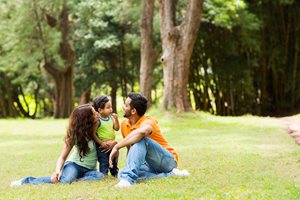Can Children on the Autism Spectrum Learn Two Languages?
By Lauren Lowry
Hanen Certified SLP and Clinical Staff Writer

 Around the world, there are more people who speak more than one language than people who speak only one language [1]. Many children on the autism spectrum, therefore, are raised in homes where multiple languages are spoken. This raises many questions for parents, such as:
Around the world, there are more people who speak more than one language than people who speak only one language [1]. Many children on the autism spectrum, therefore, are raised in homes where multiple languages are spoken. This raises many questions for parents, such as:
- Will my child be able to learn more than one language?
- Will learning a second language interfere with my child’s language development?
- What’s the best way to help my child learn two languages?
During the past decade, researchers have been studying this topic and found that being exposed to two languages does not interfere with the language development of children on the autism spectrum.
Researchers have looked at the outcomes of verbal children on the autism spectrum, and compared children exposed to one versus two languages. Children exposed to two languages appear to do as well as children exposed to only one language [2,3]. While we don’t have studies yet that have included children who do not use verbal language to communicate, we know that for verbal children on the autism spectrum, bilingualism does not harm their development [3].
Based on what we know about bilingual development, here are four tips to guide parents and caregivers of children on the autism spectrum:
- Expose your child to the language(s) that are considered important in your community and family – When parents stop speaking their native language with their child, it can result in the child not being able to understand or speak with extended family members or participate in their cultural community. Being exposed to the language(s) valued by the family can allow a child to participate more fully in their family and culture [4].
- Speak to your child in the language(s) that you are most comfortable speaking – When adults speak to children in a language that they are comfortable and fluent in, it allows children to hear a variety of words and sentences, as well as how the grammar works in that language. This helps children develop their language skills. Trying to speak a language in which you are not fluent or comfortable makes it more difficult to interact and speak with your child. We know children learn language best when they are involved in meaningful interactions during everyday life with their caregivers. Therefore, speaking fluently during everyday interactions is the best way to help a child learn language [5].
- Children need exposure to a language to learn a language – For any child to learn a language, they need to hear a lot of that language. This is also true for children on the autism spectrum, and a recent study showed that the amount of time children were exposed to a language was strongly related to their language skills [6]. Therefore, if you want your child to learn two languages, your child will need regular opportunities to hear and use both languages.
- Talk to a speech-language pathologist about supporting your child’s languages – While it’s ideal if your child’s speech-language pathologist speaks both of your child’s languages, it can be difficult to find someone who does. However, your speech-language pathologist can work with you to support your child’s languages. You can learn strategies to use with your child in any language that will build your child’s communication, interaction, and play skills. In fact, the strategies in all of the Hanen resources are intended for parents to use while speaking their choice of language with their child.
The message from researchers is loud and clear: there is no reason why children on the autism spectrum shouldn’t be raised in a bilingual environment [2]. What’s most important is that they're given the chance to have many enjoyable, meaningful interactions in both languages.
References
- Siyambalapitiya, S., Paynter, J., Nair, V. K. K., Reuterskiöld, C., Tucker, M., & Trembath, D. (2021). Longitudinal Social and Communication Outcomes in children with Autism Raised in Bi/Multilingual Environments. Journal of Autism and Developmental Disorders, 52(1), 339-348. doi: 10.1007/s10803-021-04940-x.
- Wang, M., Jegathesan, T., Young, E., Huber, J., & Minhas, R. (2018). Raising Children with Autism Spectrum Disorders in Monolingual vs Bilingual Homes: A Scoping Review. Journal of Developmental & Behavioural Pediatrics, 39(5), 434-446.
- Prévost, P. & Tuller, L. (2022). Bilingual Language Development in Autism. Linguistic Approaches to Bilingualism, 12(1),1–32.
- Smith, V., Summers, C., Mueller, V., Carillo, A., & Villaneda, G. (2018). Evidence-based Clinical Decisions Making for Bilingual Children with Autism Spectrum Disorders: A Guide for Clinicians. Perspectives of the ASHA Special Interest Groups, 3(1), 19-27.
- Trelles, M. P. & Castro, K. (2019). Bilingualism in Autism Spectrum Disorder: Finding Meaning in Translation. Journal of the American Academy of Child & Adolescent Psychiatry, 58(11), 1035-1037.
- Gonzalez-Barrero, A.M., & Nadig, A. (2018). Bilingual children with autism spectrum disorders: The impact of amount of language exposure on vocabulary and morphological skills at school age. Autism Research, 11(12), 1667–1678. https://doi.org/10.1002/aur.2023.